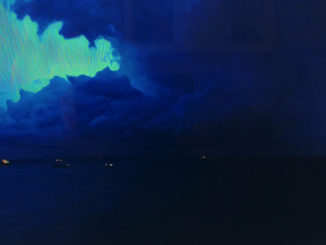San Remo
San Remo, also spelt Sanremo, is a town located in the Liguria region of northwestern Italy. It is a popular tourist destination on the Italian Riviera and is known for hosting cultural events such as the Sanremo Music Festival and the Milan-San Remo cycling classic. The city has a population of 55,000 and produces extra virgin-grade olive oil, which is a protected regional “designation of origin”. San Remo is also known as the City of Flowers (la Città dei Fiori) and features a Russian Orthodox church by the seafront, a casino, grand villas, and an almost perfectly preserved medieval village district called La Pigna.
A rich history includes having remained independent of the Genoese Republic and being annexed to the Kingdom of Sardinia after the Savoy restoration in 1814. Sanremo is also where the San Remo conference was held in 1920, which determined the allocation of Class “A” League of Nations mandates for the administration of the former Ottoman-ruled lands of the Middle East by the victorious powers.
The tourism industry first began to be realized in the mid-1700s. Several hotels were built, contributing to the city’s population growth. By 1875, the London Illustrated News was gushing about the ‘picturesque little town’ chosen by her Imperial Majesty the Empress of Russia for a winter residence. Part of a rapidly increasing popularity due to ‘the beauty of its position and salubrity of its climate.’
The News described the old town as a curious and intricate labyrinth of steep zigzagging narrow streets and dark alleys, so high with grim houses that, on account of overhanging balconies and arcades, it was rare for the passing pedestrian to spot the blue Italian Riviera sky above. The empress, born as Princess Marie Sophie Frederikke Dagmar of Schleswig-Holstein-Sonderburg-Glücksburg, will have been more impressed with the new town springing up near the sea, with handsome hotels, coquettish villas and gardens bright with orange and lemon groves – not to mention the fine sandy beach pictured below.
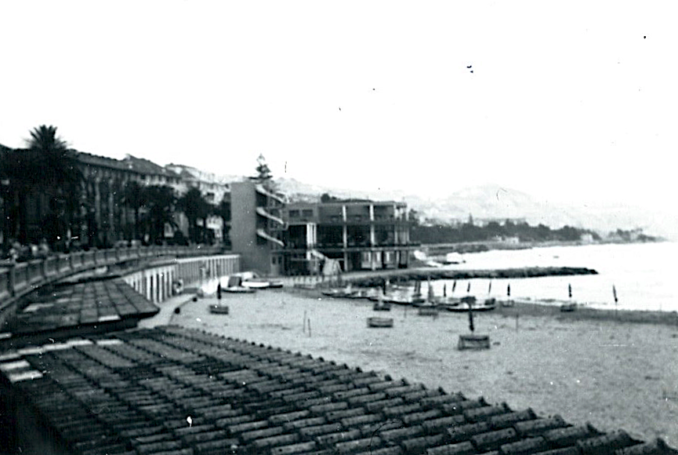
© Always Worth Saying 2023, Going Postal
San Remo was still a popular tourist destination in the 1950s, known for its mild climate, beautiful beaches and luxurious hotels. The city had recovered from the devastation of World War II and was experiencing a period of growth and prosperity. The Sanremo Music Festival had started in 1951 and was becoming a major event in the Italian cultural calendar, attracting both Italian and international artists. In addition to tourism and culture, San Remo played another important role – in international politics. In 1955, the city hosted a conference of European foreign ministers to improve relations between Western Europe and the Soviet Union.
Three years later, my grandparents visited in their Ford Prefect during the road trip we are following via an old photo album. Picture one is very findable, showing as it does a long seafront with distinctive walls and a notable building, apparently accompanied by a helter-skelter, jutting towards the sea.
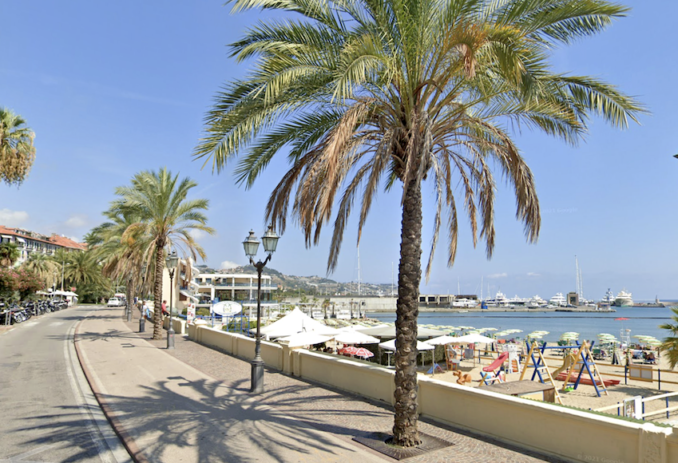
© Google Street View 2023, Google
In the modern day, that building survives and is part of the Bagni Morgana beach resort. Beachside cabins, albeit with corrugated iron roofs rather than slate, still line the Mediterranean side of the promenade. However, a synthetic football pitch and some event-type spaces detract from the sands. Behind the photographer is the castle and behind that is the casino.
Admittance to the beach resort is by hired cabin and furniture. A cabin, parasol and two deck chairs tip the scales at over €500 per month. Besides the furniture and cabins, the beach resort also has showers, changing rooms and a restaurant that serves Mediterranean cuisine. Closer inspection shows the ‘helter-skelter’ to be the Art Deco building’s spiral staircase leading to the beach house’s various terraces. The pictured buildings to the left are older and grander neighbours along a promenade known as the Corso Orazio Raimondo.
Alassio
Our next photo takes us 25 miles along the coast to just beyond Andora. No, not Andorra, the Pyrenean principality locked between France and Spain, but Andora a small town on the Riviera Delle Palme right next door to Alassio which is where my grandparents paused again.
Alassio is a popular tourist destination also located in the Liguria region of northwestern Italy. Part of the Italian Riviera it was considered as the gateway to San Marino for many British tourists during the 1950s. Alassio is known for its long, sandy beach, crystal-clear waters, and charming old town. Many tourists would spend a few days in Alassio after making their way to or from San Marino, taking in the sights and sounds of this beautiful town.
The beach of Alassio is a sandy beach with fine sand and shallow waters that make it a great spot for swimming and sunbathing. The beach is in an idyllic location, with a Saracen tower in the background, adding to its charm. The beach town is known for its family-friendly atmosphere, romantic hotels, and spa resorts. The town offers a variety of activities for visitors, including shopping, hiking, and cycling. In the 1950s, Alassio was a popular tourist destination due to its natural beauty (and pre-EU tax-free shopping), despite the political instability and recovery from World War II. Today, Alassio remains a must-visit spot for those looking for a relaxing beach vacation in Italy.

© Always Worth Saying 2023, Going Postal
As with San Remo, the exact spot photographed on the Alassio seafront is easy to locate on Street View. You can have a look around here. The island to the right is a private island called Gallinara, or Isola d’Albenga, and is famous for its Grotta della Gallinara sea caves. Once the home of hermit monk St Martin of Tours, it was owned by the church until 1842. In a sign of changed times, according to Wiki it is now in the possession of Ukrainian businessman Olexandr Boguslayev.
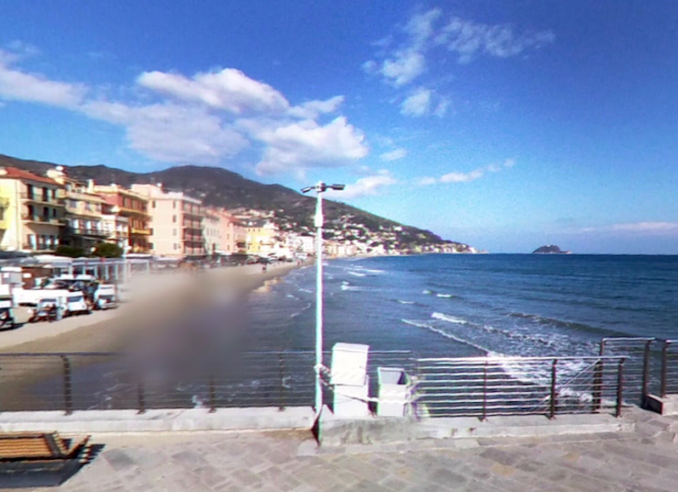
© Google Street View 2023, Google
The old photograph is taken from the town’s pier, a modest structure opposite the Hotel Ligure and known as the Pontile Mario Bestoso. As with San Remo, away from the promenade the streets are narrow. Many allow for walking only, with no room for vehicles. Along the Via Vittorio Veneto, archways connect opposite sides of the street. Balconies take up what little space remains. The square behind the Hotel Ligure is disappointing but if we persist we happen upon the Piazza Ferrero which defines a space between the Via Cristoforo Colombo and the Via Vittorio Veneto.
Jimmy’s Restaurant
Although not a particularly good match, the black and white sign above the doorway in the far building looks as though it might read Piazza Ferrero and, you never know, the building it’s attached to might have been extended up the way by an extra story in the intervening seven decades. In the mind’s eye, we will place Jimmy’s Restaurant amongst these old street lights, shutters and pastel buildings as many of the nearby piazzas are modern, garish and touristy.
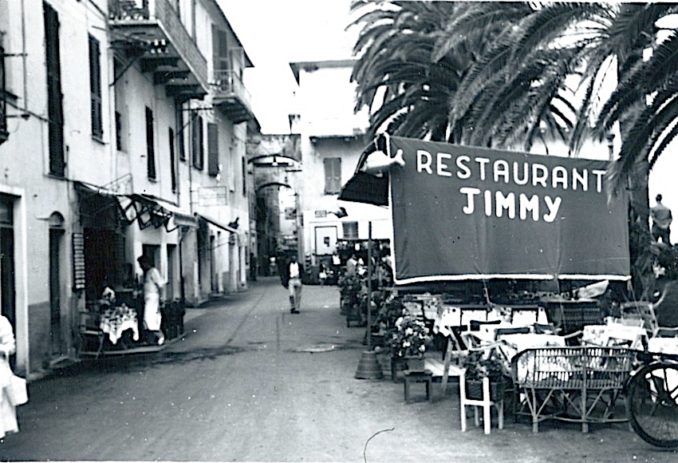
© Always Worth Saying 2023, Going Postal
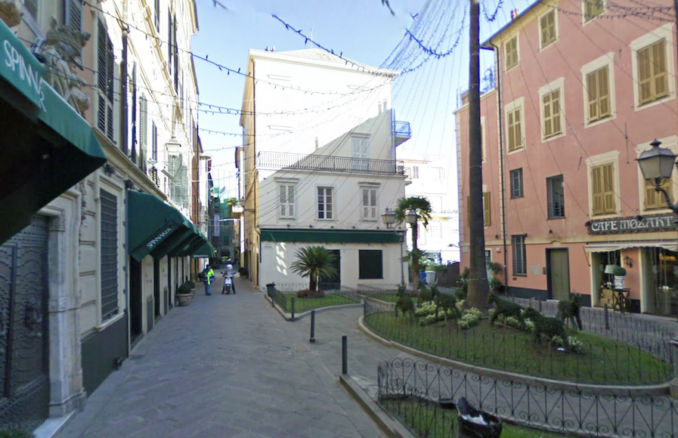
© Google Street View 2023, Google
As for the old street restaurant itself, I assumed Jimmy’s was a ‘thing’. Well-travelled Puffin sophisticates will know of the famous Jimmy’z in Monaco. The mind’s eye ran riot. Jimmy was an East End ex-pat who did rather well out of the war. After graduating as Eltham’s go-to for black market spam during the Blitz, he ran a contraband racket on the Continent. Finding himself washed up on the Rivera at the outbreak of peace, he did surprisingly well out of an eatery in the backstreets of Alassio (owned by his 18-year-old wife’s local family). Fortune smiled once more when Jimmy invested his honest gotten gains in a run-down nightclub in Monte Carlo at just the right time.
However, a search revealed nothing of a Jimmy’s Restaurant in Alassio and further investigation into Jimmy’z in Monte Carlo showed the VIP’s favourite club (where the decks are spun by the world’s top DJs and Methuselahs of champagne reign supreme) was opened in 1970 when Régine fell in love with Monaco while performing on stage there.
My new best friend, Mr A.I. Bot also drew a blank with Jimmy’s in Alassio but was able to fill me in on the ‘gos’ about Régine. As every Puffin knows, Régine was Régine Zylberberg, a Belgian-born French singer and nightclub impresario. In a life even more complicated than Jimmy the Spiv’s, Mr A.I. Bot confides that Régine owned 17 of the jet-set’s favourite watering holes, owned a dozen apartments in Paris, Monte Carlo, London, New York etc and was John Boorman’s (Deliverance, Excorist II) daughter’s mother-in-law and Sir Terance Conran’s (Habitat) daughter’s brother-in-law’s mother.
During which life well lived she secretly envied a simpler world of Ford Prefects, open roads and snacks in side street cafes.
© Always Worth Saying 2023


